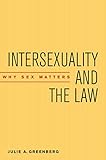Intersexuality and the Law : Why Sex Matters / Julie A. Greenberg.
Material type: TextPublisher: New York, NY : New York University Press, [2012]Copyright date: ©2012Description: 1 online resourceContent type:
TextPublisher: New York, NY : New York University Press, [2012]Copyright date: ©2012Description: 1 online resourceContent type: - 9780814731895
- 9780814738610
- 346.73013 23
- KF478.5 .G74 2016
- online - DeGruyter
| Item type | Current library | Call number | URL | Status | Notes | Barcode | |
|---|---|---|---|---|---|---|---|
 eBook
eBook
|
Biblioteca "Angelicum" Pont. Univ. S.Tommaso d'Aquino Nuvola online | online - DeGruyter (Browse shelf(Opens below)) | Online access | Not for loan (Accesso limitato) | Accesso per gli utenti autorizzati / Access for authorized users | (dgr)9780814738610 |
Browsing Biblioteca "Angelicum" Pont. Univ. S.Tommaso d'Aquino shelves, Shelving location: Nuvola online Close shelf browser (Hides shelf browser)

|

|

|

|

|

|

|
||
| online - DeGruyter The American Judaism of Mordecai M. Kaplan / | online - DeGruyter A New Critical History of Old English Literature / | online - DeGruyter Soul : Black Power, Politics, and Pleasure / | online - DeGruyter Intersexuality and the Law : Why Sex Matters / | online - DeGruyter Marginal Workers : How Legal Fault Lines Divide Workers and Leave Them without Protection / | online - DeGruyter The New Black Politician : Cory Booker, Newark, and Post-Racial America / | online - DeGruyter Tinker Belles and Evil Queens : The Walt Disney Company from the Inside Out / |
Frontmatter -- Contents -- Acknowledgments -- Introduction -- Part I. Gender Blending -- 1. Surgical and Hormonal Creation of the Binary Sex Model -- 2. Who Has the Right to Choose My Sex and Genitalia? -- Part II. Gender Bending -- 3. Legal Reinforcement of Gender Norms -- 4. Can I Marry a Man, a Woman, Either, or Neither? -- 5. What’s in a Name? -- 6. Where May I Live and Which Bathroom Do I Use? -- Part III. Legal Paths to Enhancing the Lives of People with an Intersex Condition -- 7. Developing Strategies -- 8. The History and Development of the Intersex Movement -- 9. Conflicts among Social Justice Movements with Common Concerns -- 10. Legal Frameworks -- Conclusion -- Appendix -- Notes -- Index -- About the Author
restricted access online access with authorization star
http://purl.org/coar/access_right/c_16ec
Winner of the 2013 Bullough Award presented by the Foundation for the Scientific Study of Sexuality The term “intersex” evokes diverse images, typically of people who are both male and female or neither male nor female. Neither vision is accurate. The millions of people with an intersex condition, or DSD (disorder of sex development), are men or women whose sex chromosomes, gonads, or sex anatomy do not fit clearly into the male/female binary norm. Until recently, intersex conditions were shrouded in shame and secrecy: many adults were unaware that they had been born with an intersex condition and those who did know were advised to hide the truth. Current medical protocols and societal treatment of people with an intersex condition are based upon false stereotypes about sex, gender, sexual orientation, gender identity, and disability, which create unique challenges to framing effective legal claims and building a strong cohesive movement. In Intersexuality and the Law, Julie A. Greenberg examines the role that legal institutions can play in protecting the rights of people with an intersex condition. She also explores the relationship between the intersex movement and other social justice movements that have effectively utilized legal strategies to challenge similar discriminatory practices. She discusses the feasibility of forming effective alliances and developing mutually beneficial legal arguments with feminists, LGBT organizations, and disability rights advocates to eradicate the discrimination suffered by these marginalized groups.
Mode of access: Internet via World Wide Web.
In English.
Description based on online resource; title from PDF title page (publisher's Web site, viewed 06. Mrz 2024)


